by Philippe Faucon (2001)
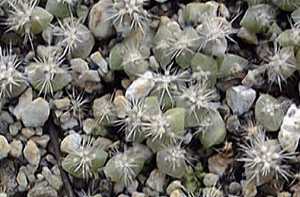 These sahuaro seedlings are 4 weeks old, 5 mm wide |
Seeds are an inexpensive way to add specimens to your collection. Seeds are readily available from mail order catalogs, internet or other sources like clubs or friends. You might also want to try using your own seeds.
|
|
In general cactus seeds grow well just sown at the surface of regular cactus potting mix. A little of silica sand spread over the seeds will protect them. As a rule of thumb, the thickness of the sand should be the same as the diameter of the seeds. If the seeds are small, a salt shaker is a good way to spread them regularly. In any case seeds planted too thickly encourages disease and die-offs. Do not forget to label your containers! |
 |
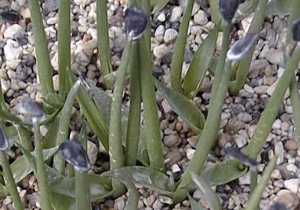 Agave parryi huachucensis, 4 weeks old |
The young seelings must be protected from drying. They can be sowed in a container that closes. The pot in which they are can be covered with a piece of glass pane. Or, if you have a large quantity they can be grown in a poly "tent", like the picture on the right (picture by James Pickering). The poly tent is open during the day. In any case the surface of the mix should never dry up. The containers should be misted once or twice a day until the seeds have germinated. Seeds need heat to germinate, and a temperature of 70 to 80°F (20-25°C) is good for most of them. Although most succulents germinate in 2 weeks or less, some species can take several months to germinate, so you might have to be patient. |
|
Clean culture is important to avoid damping off. Although fungicides can sometimes be used, using sterilized soil and cleaning all the equipment carefully before using it will go a long way in avoiding problems The seedlings need bright light and sufficient temperature. Bach's nursery keep a minimum temperature of 50°F (10°C) at night, and the day temperature is probably between 70 and 80°F (20-25°C). Remember that even if seedlings like the Pachypodiums on the right seem robust, they generally have a fragile, shallow root system, and should never have a chance to dry. |
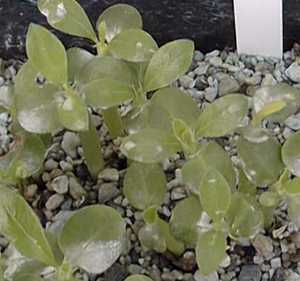 Pachypodium saundersii, 6 weeks old |
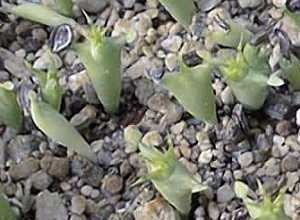 Hoodia macracantha, 8 weeks old |
Without letting them dry, they should be "hardened off" as soon as the true leaves are appearing. This means opening slightly the container in which you are growing them, or opening the poly "tent" during the day, as the picture shows. If the seedlings turn brownish, it might mean that they don't have enough humidity. On the other hand, keeping the air too humid encourages algae and fungi. The seedlings can be fertilized with liquid fertilizer as soon as they have their first real leaves (or stem for cactus). |
|
They can be moved when they are too crowded, or when they are large enough to handle. Overcrowding promotes rot, so don't wait too much. Moving them after a little watering has softened the soil, is generally easier and creates less damage. |
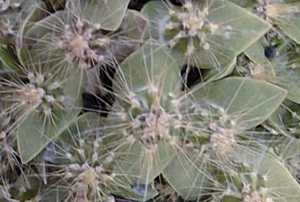 Pachycereus pectiniferus, 4 weeks old |
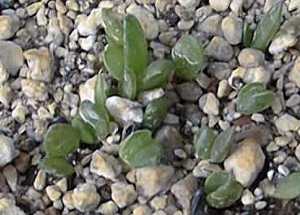 Aloe broomii, 6 weeks old |
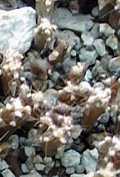
Tweezers can be used to move your young plants. A simple tool made of a wooden label with a notch cut on an edge can also be very useful.
(The picture on the right is Castellanosia caineana, 4 weeks old) |
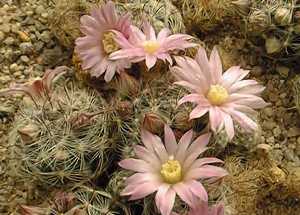 Krainzia breviflora, 1 year old, already blooming |
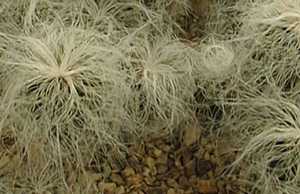 Cephalocereus senilis, 9 months old, 1 inch tall (2.5 cm) |
|
Desert Tropicals Home Page List of All the Plants /b> Desert-Tropicals is dedicated to provide gardening advice, gardening ideas, and information about flower of all kind for landscape and collections.We try to check carefully the identification of the plants on the illustrations as well as the other information from the page, but occasionally errors do occur. if you notice anything that needs to be changed please contact us.Thanks. © 1998-2020 Philippe Faucon, All Rights Reserved. |